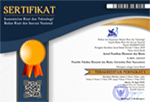Selection of a Sustainable Strategy Using DSS for Students in Selecting the Faculty of Economics and Business with the Topsis Method
DOI:
https://doi.org/10.33633/jpeb.v8i1.7559Abstract
Universities must be able to predict opportunities and challenges with the right interest in the students choosing majors in higher education in the digitalization era. This study provides the right strategy for FEB UDINUS by proposing a structural hierarchical model to analyze changes in student decision-making patterns in choosing the Faculty of Economics and Business at Dian Nuswantoro University in the digital market era by taking the context of sustainable value. The data collection techniques used in-depth interviews to determine student’s decision-making criteria in choosing FEB majors. The analysis of decision making factors was processed using TOPSIS (Technique for Order Preference by Similarity to Ideal Solution). The results of this study show the ranking strategy of the most appropriate ranking such as the strategy to find credible partner, the strategy to provide additional community benefits, the strategy to educate the community, the strategy for building collaboration between students, the strategy for creating iconic brands, the strategy for building collaboration between faculty and students, the strategy for building new learning models, and the strategy for building a new learning culture. Keywords:Sustainable strategy, DSS, Topsis MethodReferences
Abbasi, M.S., Chandio, F.H., Soomro, A.F., & Shah, F. (2011). Social influence, Voluntariness, Experience and the Internet
Acceptance: An extension of Technology Acceptance Model within a South-Asian Country Context. Journal of Enterprise Information Management, 24(1), 30-52.
Confos, N., Confos, N., Davis, T., & Davis, T. (2016). Young Consumer-brand Relationship Building Potential Using Digital Marketing. European Journal of Marketing, 50(11), 1993-2017.
Evans, S., Vladimirova, D., Holgado, M., van Fossen, K., Yang, M., Silva, E. A., & Barlow, C. Y. (2017). Business Model Innovation for Sustainability: Towards a Unified Perspective for Creation of Sustainable Business Models. Business Strategy and the Environment, 26(5), 597–608. https://doi.org/10.1002/bse.1939
Filieri, R. (2015). What Makes Online Reviews Helpful? A diagnosticity-adoption Framework to Explain Informational and Normative Influences in e-WOM. Journal of Business Research, 68(6), 1261-1270.
Fullam, J. (2017). Becoming a Youth Activist in The internet Age: a Case Study on Social Media Activism and Identity Development. International Journal of Qualitative Studies in Education, 30(4), 406-422.
Grant, J. (2009). The Green Marketing Manifesto. John Wiley & Sons Ltd.
Kumar, A., Mangla, S. K., Luthra, S., Rana, N. P., & Dwivedi, Y. K. (2018). Predicting Changing Pattern: Building Model for Consumer Decision Making in Digital Market. Journal of Enterprise Information Management, 31(5), 674–703. https://doi.org/10.1108/JEIM-01-2018-0003
Kotler, Philip and Amstrong, Gary. (2012). Principles of Marketing, Fourteen Edition, England: Pearson Education Limited.
Primasari, C. H., Wardoyo, R., & Sari, A. K. (2018). Integrated AHP, Profile Matching, and TOPSIS for Selecting Type of Goats Based on Environmental and Financial Criteria. International Journal of Advances in Intelligent Informatics, 4(1), 28–39
Risnawati, E., & Irwandi, S. A. (2015). Analisis Faktor Atas Pengambilan Keputusan Mahasiswa Untuk Memilih Jurusan Akuntansi Di Stie Perbanas Surabaya. The Indonesian Accounting Review, 1(01), 63. https://doi.org/10.14414/tiar.v2i01.318
Royle, J., & Laing, A. (2014). The Digital Marketing Skills Gap: Developing a Digital Marketer Model for the Communication Industries. International Journal of Information Management, 34(2), 65-73.
Shaouf, A., Lü, K., & Li, X. (2016). The Effect of Web Advertising Visual Design on Online Purchase Intention: An examination Across Gender. Computers in Human Behavior, 60, 622-634.
Srinivasan, S., Rutz, O. J., & Pauwels, K. (2016). Paths to and off Purchase: Quantifying the Impact of Traditional Marketing and Online Consumer Activity. Journal of the Academy of Marketing Science, 44(4), 440-453.
Tang, L. C., & Seng, C. (2017). Factors Influence Students’ Choice of Accounting Major in Cambodian Universities. Asian Review of Accounting, 23(3), 232–255. https://doi.org/10.1108/ARA-04-2012-0017
Tan, K.S., Chong, S.C., Lin, B., & Eze, U.C. (2010). Internet-based ICT Adoption Among SMEs: Demographic Versus Benefits, Barriers, and Adoption Intention. Journal of Enterprise Information Management, 23(1), 27-55.
Wu, J. F., Wu, J. F., Chang, Y. P., & Chang, Y. P. (2016). Multichannel Integration Quality Online Perceived Value and Online Purchase Intention: A Perspective of Land-Based Retailers. Internet Research, 26(5), 1228-1248.
Zhu, F., & Zhang, X. (2010). Impact of Online Consumer Reviews on Sales: The Moderating Role of Product and Consumer Characteristics. Journal of Marketing, 74(2), 133-148.
Downloads
Published
How to Cite
Issue
Section
License
The copyright of the received article shall be assigned to the journal as the publisher of the journal. The intended copyright includes the right to publish the article in various forms (including reprints). The journal maintains the publishing rights to the published articles.
This work is licensed under a Creative Commons Attribution 4.0 International License.


.png)









